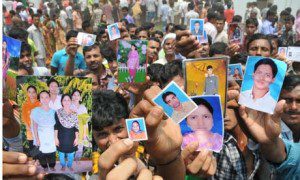Contributing Writer for Wake Up World
I can’t help but feel that there is something terribly wrong with our world when over 1,134 children, women and men fall to their death in a tragically unsafe building in India, designed to churn out cheap clothing for people in the western world.
But the question that really burns my heart is “how many people need to die before people really start to do something about it?”…
The Tragedy of Fashion
Just over one year ago, on the 24th of April 2013, the eight storey Rana Plaza building collapsed, causing the deaths of over 1,134 workers whilst injuring over twice as many again. It left a huge trail of tragedy and suffering.
The factories within it were sorely over-populated, providing cramped conditions to knock out cheap clothing for companies like Walmart, Primark, Benetton, Matalan and the Children’s Place. The upper floors had been built without a permit, ignoring just about every sensible safety precaution in the book. It’s a heart wrenching disaster, destined to happen from the start, especially given that the building’s architect insists that it was never designed for factory use and heavy machinery.
Unfortunately such unsafe conditions seems to be common place in less developed countries. The day before the disaster, media reported a crack in the building. Whilst the shops and bank in the building were immediately closed, the factory garment workers were forced to work as usual. For most workers, their job is their life-blood and not going to work means they’d be fired, punished or not paid – which is tragically not an option for people who can barely scrape together enough to live as it is.
I watched this video. It interviews some of the the brave survivors of the disaster including one woman who tried to cut her hand off in order to free herself from death.
The Victims of Rana Plaza, Bangladesh
Were All Those Deaths in Vain?
You’d be forgiven for presuming that this sort of disaster would immediately invoke change. In some ways the cogs have started moving as the event has brought the issues of sweatshops to the forefront over the past year. In other ways, progress is painfully slow and thwarted.
Take for instance the brave stance by former workers who took to the streets six weeks after the disaster to protest about their appalling treatment. Instead of being listened to, the police opened fire on them and cleared the streets with tear gas — as reported in the Guardian newspaper.
This scene is echoed throughout countries like Bangladesh, Cambodia, India, Sri Lanka and Indonesia as workers are forced to work for wages that barely allow them the basics of clean clothing, shelter and food to feed themselves and their families. I’ve read countless stories over the years where kids are also forced to work since there is no other way to survive. It’s not uncommon to hear that they are forced to work in inhumane, cramped conditions; inhaling toxins that have been banned in western factories; being forced to work insanely long hours without adequate breaks; being injured by unsafe practices.
Fashion and Destruction of the Environment
Most awakened people think of avoiding food that is laden with chemicals, yet many haven’t yet made the link between what we wear and destruction of the environment. It’s quite startling to realise what insane levels of pollution we might be contributing to because of what we wear. Check out this short video to see how Greenpeace is bringing the message forward for a positive ‘detox your fashion’ change.
Leather, Fur and Other Animal Products
It’s often believed that leather, fur and other animal products used for clothing are a by-product of the meat industry, which in itself is worth questioning. Whilst this may at times be the case, most people are not aware of the life cycle that brings them leather and other such products. If you are in any doubt, then I would urge you to watch this short clip from the Earthlings documentary that shows us how leather finds its way to us.
A Living Wage Should Be Enough to Actually Live On
There are organisations around the world campaigning for living wages. You might think that a minimum wage would be enough to live on but it’s often far from adequate. In Cambodia for instance, the minimum wage is US$61 per month, where in fact, the minimum amount required to live (to provide basic living costs) is US$238. People who challenge this system there are often punished, fired or even jailed.
Watch this short animated video for more information on this:
“Never doubt that a small group of thoughtful, committed citizens can change the world; indeed, it’s the only thing that ever has” ~ Margaret Mead
What Can We Do?
So what can we do right now to make a difference in our every day lives?
Buy pre-owned clothing
People often donate unwanted (but perfectly fine) clothing to their local charity/thrift stores. Most towns and cities also have a 2nd hand clothing shops. This is an excellent way to buy ethically by re-using and recycling unwanted goods.
Find ethical clothing companies
Most cities these days have at least somewhere that stocks organic, ethical or conscious clothing that has been produced in fair conditions by a company that values the environment, people and fair living wages. You might have to do a little searching to find these places, but it is really worth making the effort. You’ll more likely find them online. They are often more expensive that cheap high-street brands, but remember the time and energy that is actually put into providing your garments. If you buy only that which you need, then you will probably find that you have more than enough.
High street
The one place in our world that is crawling with the neatly packaged karma of pain and suffering is the typical high street. Sweatshop labour is responsible for decking out most of the clothing shops we see. If you shop in high street chain stores, then you can still become a more conscious shopper and help instigate change. Do some investigating. Find out which stores stock fairly traded products. Write to them and demand that they address their ethics. Some stores are beginning to wake up and look at implementing ethical policies.
Ethical Consumer is a UK based magazine and has drawn up a rated list of high street clothing stores, based on their ethics. Outside the UK, you might find other guides for your own country. (If you do, share them in the comments section below).
Fairtrade Clothing
Every time you buy something that doesn’t carry the Fairtrade mark, you can probably assume that whatever you are wearing has been responsible for suffering somewhere down the line. Look for the fairtrade label (especially on the high street) when you buy anything. If it’s not there, then ask why not.
We can change things by making conscious choices.
Each of us has a choice. Every choice counts and sends a message to the world.
So, what message are you going to share with the world?
Recommended articles by Trinity Bourne:
- 10 Reasons Why We all Should be Eating Ginger – Recipes Included
- Recipe: Green Superfood Smoothie Jam Packed with Health Benefits
- Top Tips for Making Deliciously Healthy Salads
- Ethical Conscious Clothing – Ending Modern Day Slavery
- The Importance of Eating Seeds for a Healthy Diet – Tips, Benefits & Recipes
- Foraging Guide – with 12 Nutritious Wild Plants That Anyone Can Find
- Keeping Slugs & Snails Off Your Veggies – Compassionately
- Being an Empath
- Chocolate Paradise Coconut Bar Recipe – Vegan, Raw, Absolutely Delicious!
- The Superfood Health Benefits of Celery (with Recipes!)
- The Spirit of the Dolphin
- Chocolate Covered Coconut Bliss Bars (Vegan, Gluten-Free, No-Bake)
About the author:
Trinity is an experienced, empathic energy worker and the author of ‘Trinity’s Conscious Kitchen’ and ‘Angelicious’, recipe books designed to inspire the soul through conscious vegan, wheat-free and gluten-free cuisine.
22 years ago Trinity had a profound spiritual awakening that interconnected her with the deeper consciousness of life. What followed was a journey of compassion for all sentient beings, and a passion to share conscious eating for the benefit of all. Understanding that the energy of our food directly impacts sentient life on all levels, Trinity founded Trinity’s Conscious Kitchen, a website devoted to inspiring the soul through conscious, plant-based cuisine. She is also the co-founder of Openhand, an organisation dedicated to the conscious evolution of humankind.
For more, visit trinityskitchen.com and follow Trinity’s Kitchen on Pinterest and Facebook!

If you've ever found value in our articles, we'd greatly appreciate your support by purchasing Mindful Meditation Techniques for Kids - A Practical Guide for Adults to Empower Kids with the Gift of Inner Peace and Resilience for Life.
In the spirit of mindfulness, we encourage you to choose the paperback version. Delve into its pages away from screen glare and notifications, allowing yourself to fully immerse in the transformative practices within. The physical book enriches the learning process and serves as a tangible commitment to mindfulness, easily shared among family and friends.
Over the past few years, Wake Up World has faced significant online censorship, impacting our financial ability to stay online. Instead of soliciting donations, we're exploring win-win solutions with our readers to remain financially viable. Moving into book publishing, we hope to secure ongoing funds to continue our mission. With over 8,500 articles published in the past 13 years, we are committed to keeping our content free and accessible to everyone, without resorting to a paywall.








